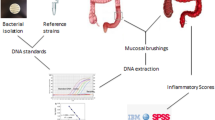Abstract
A pathogenic role of nitric oxide has beensuggested in acute and chronic intestinal inflammation.We took the opportunity offered by studies in patientswith excluded colon, which represents a model of chronic intestinal inflammation with noexogenous nitrite or nitrate supply, to evaluate thequantity and the quality of nitrate reducers indiversion colitis. Thirty patients (17 men, 13 women,mean age 45 years) having an excluded colonfor variousreasons were sampled by rectal swabs and compared to 30healthy controls (11 men, 19 women, mean age 28 years).The percentage of nitrate-reducers among the total count of subcultured bacteria was 46± 41% (mean ± SD) in patients withdiversion colitis as compared to 19 ± 24% inhealthy controls. This difference was significant (P< 0.05) despite great heterogeneity in individual values. In patientswith diversion colitis, 75/254 (29.5%) differentisolated bacterial strains were nitrate-reducers ascompared to 61/294 (21%) (P < 0.05) in controls.Among the 75 nitrate-reducing strains isolated frompatients with diversion colitis, 55 were aerobes.Pseudomonas species were only encountered in thispopulation. The predominant group was enterobacteriawith a high isolation rate of species belonging tothe genera Proteus, Providencia, and Morganella . Inhealthy controls nitrate-reducing anaerobes were nearlyas frequent as aerobes. The most frequent species was Eubacterium lentum, followed by Clostridiumperfringens. It could be suggested that nitric oxidesynthase might produce a bacterial substrate increasingthe growth of bacteria with a high pathogenic potential, creating conditions for chronicinflammation and infection in patients with excludedcolon.
Similar content being viewed by others
REFERENCES
Roediger WEW, Radcliffe BC: Role of nitrite and nitrate as a redox couple in the rate colon. Gastroenterology 94:915–922, 1988
Krieg NR, Holt JG: Bergey's Manual of Systematic Bacteriology. Baltimore, Williams and Wilkins, 1984
Moncada S, Higgs A: The L-arginine oxide pathway. N Engl J Med 329:2002–2012, 1993
Wettig K, Schulz KR, Scheibe J, Diener W, Fischer G, Namaschk A: Endogenous nitrate synthesis in selected infectious diseases and ulcerative colitis. Neoplasmia 38:337–341, 1991
Middleton SJ, Shorthouse M, Hunter JO: Increased nitric oxide synthesis in ulcerative colitis. Lancet 341:465–466, 1993
Lundberg JON, Hellström PM, Lundberg JM, Alving K: Greatly increased luminal nitric oxide in ulcerative colitis. Lancet 344:1673–1674, 1994
Rachmilewitz D, Karmeli F, Okon E, Bursztyn M: Experimental colitis is ameliorated by inhibition of nitric oxide synthase activity. Gut 37:247–255, 1995
De Groote MA, Fang FC: NO inhibitions: Antimicrobial properties of nitric oxide. Clin Infect Dis 21:S162–165, 1995
Schoedon G, Schneemnn M, Walter R, Blau N, Hofer S, Schaffner A: Nitric oxide and infection: Another view. Clin Infect Dis 21:S152–S157, 1995
Eisenstein TK, Huang D, Meissler JJ, Al-Ramadi B: Macrophage nitric oxide mediates immunosuppression in infectious inflammation. Immunobiol 191:493–502, 1994
Glotzer DJ, Glick ME, Goldman H: Proctitis and colitis following diversion of the fecal stream. Gastroenterology 80:438–441, 1981
Neut C, Colombel JF, Guillemot F, Cortot A, Quandalle P, Ribet M, Romond C, Paris JC: Impaired bacterial flora of the excluded colon. Gut 30:1094–1098, 1989
Holdeman LV, Cato EP, Moore WEC: Anaerobe Laboratory Manual, 4th ed. Blacksburg, Virginia Polytechnic Institute, 1977
Hernandez D, Dias FN, Row GH: Nitrate transport and its regulation by O2 in Pseudom onas aerugonisa. Arch Biochem Biophys 286:159–163, 1991
Muller HE: Occurrence and pathogenic role of Morganella-Proteus-Providencia group bacteria in human feces. J Clin Microbiol 23:404–405, 1986
Ruseler-Van Embden JGH, Schouten WR, Van Lieshout LMC: Pouchitis: Result of microbial imbalance? Gut 35:658–664, 1994
Finegold SM, Sutter VL, Boyle JD, Shimada K: The normal flora of ileostomy and transverse colostomy effluents. J Infect Dis 122:376–381, 1970
Gorbach SL, Nahas L, Weinstein L, Levitan R, Patterson JF: Studies of intestinal microflora IV. The microflora of ileostomy effluent: A unique microbial ecology. Gastroenterology 53:874–880, 1967
Owens MW, Grisham MB: Nitric oxide synthesis by rat pleural mesothelial cells: induction by cytokines and lipopolysaccharides. Am J Physiol 265:L110–116, 1993
Ohshima H, Bartsch H: Chronic infections and inflammatory processes as cancer risk factors: Possible role of nitric oxide in carcinogenesis. Mutat Res 305:253–264, 1994
Chestrown SE, Monnier J, Visner G, Nick HS: Regulation of inducible nitric oxide synthase mRNA levels by LPS, IFN-α, TGF-α and IL-10 in murine macrophage cell lines and rat peritoneal macrophages. Biochem Biophys Res Commun 200:126–134, 1994
Sekiguchi S, Seki S, Ishimoto M: Putrification and some properties of nitrite reductase from Clostridium perfingens. J Biochem 94:1053–1059, 1983
Rights and permissions
About this article
Cite this article
Neut, C., Guillemot, F. & Colombel, J.F. Nitrate-Reducing Bacteria in Diversion Colitis (A Clue to Inflammation?). Dig Dis Sci 42, 2577–2580 (1997). https://doi.org/10.1023/A:1018885217154
Issue Date:
DOI: https://doi.org/10.1023/A:1018885217154




